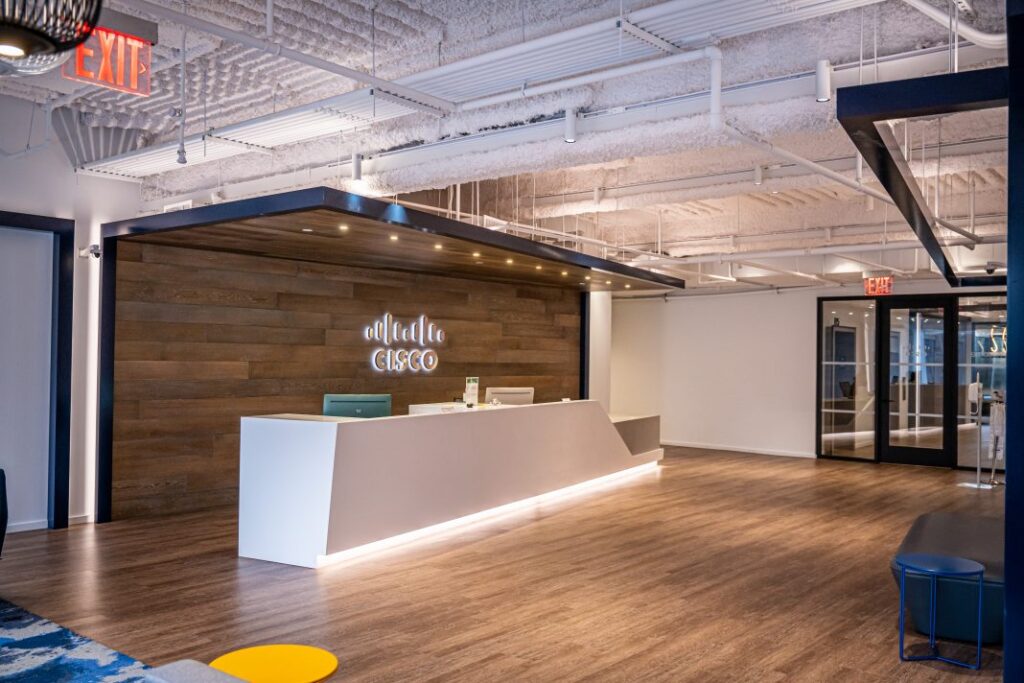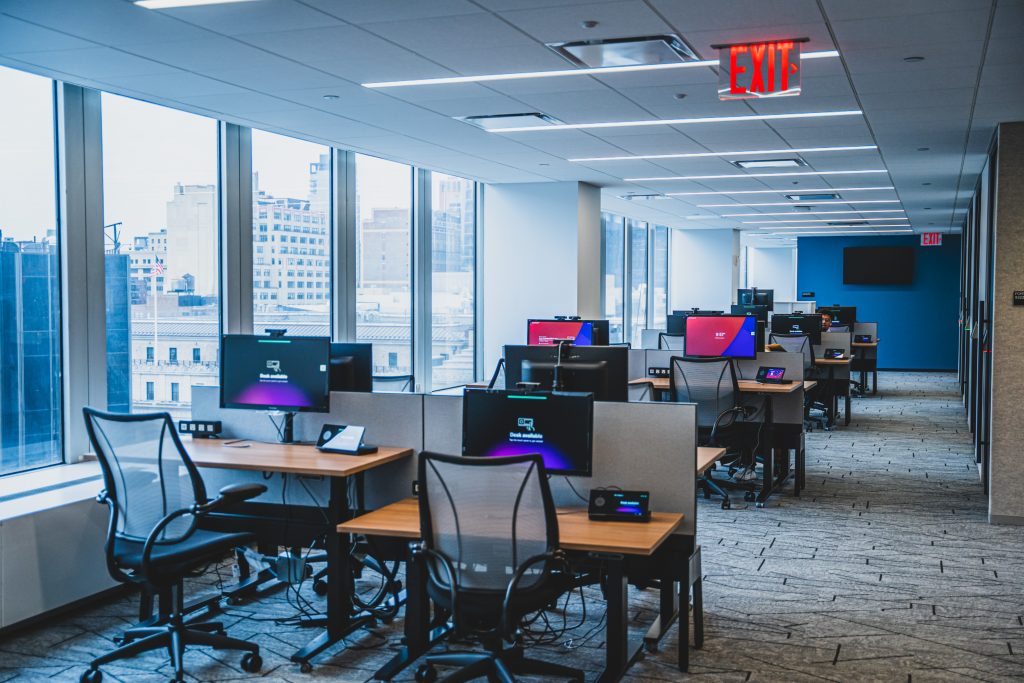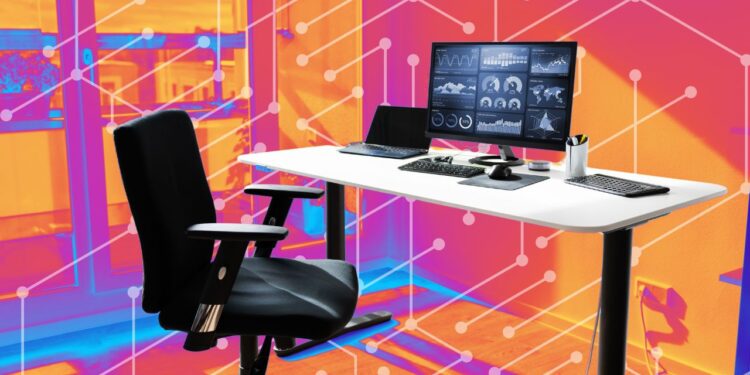- Humans lead in idea generation, enhanced by AI’s data analysis, creating innovative, employee-centered workspaces.
- Companies like Cisco implement intelligent desks and IoT-enabled office solutions to improve employee wellness, satisfaction, and space flexibility.
- Smart furniture uses PoE connectivity to gather real-time data, driving automation, energy efficiency, and informed workplace strategies.
This article was written by Akram Khalis, CEO of MHT Technologies and the co-founder of Inspextor, for Work Design Magazine.
Human beings are the premier source of new ideas. At least for now. Artificial intelligence is trying its not-yet-sentient best to reset the scales of innovation.
Today, however, the forces are working in concert, layering wicked-fast data analysis on top of tenured design mastery to build never-before-experienced spaces all over the world.
Because humans are still in charge, we are supremely dialed in on building spaces that are actually good for the people who occupy them. Namely, we are leaning in on the development of comfortable, healthy and sustainable workplaces.
Leveraging a slew of technological advancements, architecture and IT teams are designing office-space blueprints with employee health and satisfaction at the center.
Intelligent Desks Lead the Way in Smart Furniture Adoption
Smart furniture and the insights-rich data it generates is one area that has wellness-focused design teams excited about the possibilities of next-generation workplaces.
Recent data shows that although more employees may be returning to the office, not all of them are happy about it. Ongoing challenges related to talent shortages, high turnover and hybrid work has accelerated the need for flexible, responsive offices that conform to—even anticipate—employees’ preferences to make going to the office as enjoyable as possible.

Intelligent desks are a pioneering use case, in place now in offices across the globe, including Cisco’s New York City and Atlanta locations. It’s perhaps no surprise that the American technology company, which specializes in IT networking, finds value in connecting its own office furniture to the Internet.
Yet Cisco’s smart furniture strategy is about much more expanding the Internet of Things (IoT). The company also finds value in the flexibility of intelligent desks.
Most companies that employ people on-site are grappling with many uncertainties regarding space planning and utilization. Because the desks can be moved to different locations without core drilling to relocate electrical outlets, they provide major time and cost savings.
According to Cisco’s Bob Cicero, smart furniture also supports the company’s culture.
“One of Cisco’s principles is to bring our individuality to work,” said Cicero, hybrid work and sustainable real estate leader.
Smart spaces adapt to whatever puts each employee at the top of their game.
Hoteling Goes Next Level with Environmental Preferences
Even before the integration of IoT-enabling features, the office desk had become something of a nerve center for workplace innovation. Space-optimizing strategies like hot-desking and hotelling, for instance, centered mainly around the desk, configuring who would use which desk and when.
Now, with the addition of devices, sensors, actuators and pneumatics, smart desks are playing an even bigger role in the adaptation of the hive to its worker bees. We’re no longer limited to who, which and when factors. Now, we can even consider adapting the desk to how a particular employee likes to work.

At Cisco, for instance, employees who enter the office are met with a touchscreen dashboard that empowers them to choose and reserve a desk for the next hour, next day or the full week. The dashboard also displays real-time data on the occupancy, temperature, humidity, CO2 and ambient noise in the space surrounding the desk.
Team members facing a hard deadline or those who work best in a noisy environment now have much more control over their workday destinies (and may be more likely to opt into working at the office rather than at home).
All of the real-time data from the desk comes into the Cisco Spaces platform, which enables the seamless interaction of lighting, shades, HVAC sensors and the people using the space. The desk itself is powered, connected and, importantly, interconnected to the IoT ecosystem, using Power-over-Ethernet (PoE) delivered from Catalyst 9000 switches.
PoE is low-voltage, flexible and highly scalable, which is why it’s found in many of today’s digital building renovation projects.
Owners seeking to transform static, power-hungry properties into sustainable, smart buildings are increasingly turning to the IT infrastructure for a relatively low-cost energy alternative. For Cisco, this has provided insights that have helped them achieve safer workspaces, smarter buildings and more sustainable places to work.

Automation Defines “Smart”
Control is only half of the benefit of smart furniture. Automation is the other. In fact, a smart building isn’t a smart building without it.
The intelligence of anything in the expanding IoT is based on the component’s ability to respond to external factors, such as the presence of a human or of sunlight.
Intelligent lighting, for instance, autonomously changes color temperature based on the pre-set preferences of the face (or palm print or RFID badge, etc.) that’s in the space. Smart shades automatically rise or drop when the system detects too many or too few rays are making their way into the windows.
Automation in smart desks is as limited as the imagination. Some of the use cases already in-market include desks that transition from sitting to standing configurations when they detect their occupants have been sitting for too long; kinetic monitors that change position subtly throughout the workday to promote neck and back movement; embedded whiteboards that automate dissemination of meeting notes and next steps; and projection that sends a screen’s info to a nearby wall when the employee swivels away.

What’s Next for Smart Furniture at Work
Closed-loop feedback will be essential for continued improvement of the smart furniture industry. Desks that offer AI-powered control and automation will begin to ask their humans, “How did I do?” Humans will be incentivized to respond truthfully so that the system gets good, clean data to feed its models, and organizations can more fully live out their diversity and inclusivity strategies.
After all, what puts one employee at the top of her game may put another at the bottom of hers.
Companies that are investing in smart furniture and the redesign of their office spaces to accommodate it are naturally interested in ROI. Things like employee satisfaction and wellness are notoriously difficult to quantify. Therefore, executive sponsors of smart renos may do well to turn decision-makers’ focus to the business intelligence benefits of smart furniture.
Particularly when powered by PoE, smart furniture begins generating rich workforce insights immediately upon deployment. HR and operations teams can see from Day 1 how many employees took advantage of the experience, for how long and in what ways. They can then use that information to set better strategies for comfort and productivity.
Combine that intelligence with feedback from dynamic employee listening strategies, and bosses have a nearly direct line of sight into what it takes to bring more employees, happily, back to the office.

 Dr. Gleb Tsipursky – The Office Whisperer
Dr. Gleb Tsipursky – The Office Whisperer Cat Johnson – Coworking Marketing Maven
Cat Johnson – Coworking Marketing Maven Angela Howard – Culture Expert
Angela Howard – Culture Expert Drew Jones – Design & Innovation
Drew Jones – Design & Innovation Andrea Pirrotti-Dranchak – Competitive Advantage
Andrea Pirrotti-Dranchak – Competitive Advantage Jonathan Price – CRE & Flex Expert
Jonathan Price – CRE & Flex Expert Jeremy Fennema – Tech Innovation Alchemist
Jeremy Fennema – Tech Innovation Alchemist











